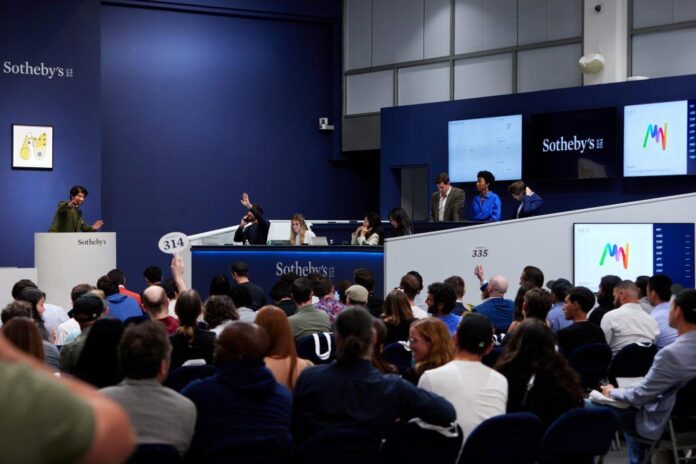What crypto winter? That’s one conclusion that could be drawn from the second round of Sotheby’s sale of the hundreds of NFTs collected by the defunct crypto hedge fund Three Arrows Capital.
At least, that’s the assessment the auction house may be hoping for. And not without reason. At the close of “Grails Part II”, which took place both online and IRL in New York on June 15, all 37 NFTs exceeded their high estimates with the grand total falling just shy of $11 million and taking the total from the series to $17 million.
“A white-glove auction,” Sotheby’s rejoiced on Twitter with an accompanying pair of clapping hand emojis.
More than 50 percent of buyers at the sale were under 40, and 61 percent were new to Sotheby’s. If one aim of Sotheby’s full-bodied move into the NFT space was to capture a different, younger clientele, it may be working.
“The sale proved works of exceptional quality continue to command the attention of serious collectors,” Sotheby’s digital art head Michael Bouhanna said. “Many [NFTs] setting significant new benchmarks for the artists since the peak of the market in 2021.”

Dmitri Cherniak, “Ringers #879 (The Goose)”, 2021. Image: courtesy Sotheby’s.
There are, however, caveats here. First, as suggested by the sale’s title, Three Arrows Capital was a selective, if ravenous, collector and the generative NFTs at Sotheby’s are ones that those with crypto to burn believe are rare and will hold value. This is to say, it’s not reflective of the whole market.
Second, the result is heavily weighted by Dmitri Cherniak’s , which saw 10 minutes of frenetic phone bidding and ultimately sold for $6.2 million, double its pre-sale high estimate. It’s now the second most expensive work of generative art after . The buyer, the anonymous Punk 6529, will also receive a signed print by the artist.
It’s one of 1,000 works in which Cherniak experimented with the infinite ways a string might move around pegs with the alterations of pegs, sizing, wrap pattern, and coloration producing wildly different results. The work was bought by Three Arrows Capital in 2021 for $5.8 million and holds particular cache within the digital art community for the fact the algorithm has miraculously created a work resembling a goose. By comparison, the other three “Ringers” sold for a combined total of less than $500,000.

Snofro, “Chromie Squiggle, #1780” 2020, Image: courtesy Sotheby’s.
Punk 6529 expressed this sense of awe in a statement following their latest Blue Chip NFT acquisition. “Once the algorithm is committed to the blockchain, nobody knows what outputs it will produce. The Goose represents this more clearly than any generative NFT. We could have run the Ringers mint thousands of times without producing anything like it again.”
Other notable sales were two of Tyler Hobbs’s “Fidenza” works that create flow fields out of variated rectangles. and both exceeded $600,000. One of Snofro’s technicolored squiggles, , which sold for $635,000, more than triple its high estimate.
There were more than 300 works from Three Arrows Capital’s collection green lit for sale and Sotheby’s has confirmed that more auctions will be taking place across the summer.

Tyler Hobbs, “Fidenza #479”, 2021. Image: courtesy Sotheby’s.

























